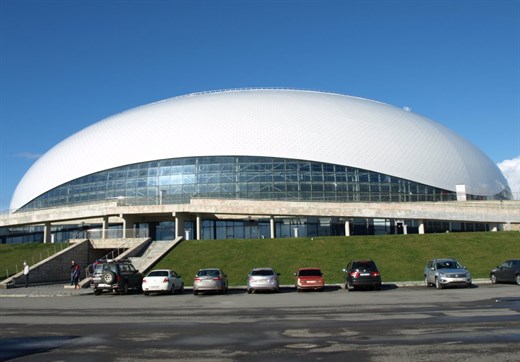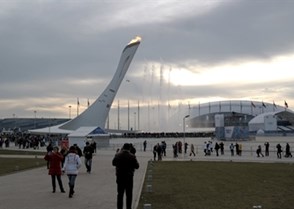Information
Tournament Format
The teams and groups were seeded according to the 2012 IIHF Women’s World Ranking. The tournament includes the top-six nations and two qualifiers. The top-four ranked teams are seeded in Group A, the other teams in Group B.
The 2014 Olympic Winter Games Women’s Ice Hockey Tournament is to operate between 8 and 23 February 2014.
The teams will compete in the 22-game schedule including 12 Preliminary Round Games, 2 Quarter-Final games, 2 Semi-Final Games, 4 Final Classification Games, one Bronze Medal Game and one Gold Medal Game.
At the conclusion of the 12-game Preliminary Round the teams finishing 1A and 2A will receive a bye for the Semi-Finals. Teams finishing 3A, 4A, 1B and 2B will advance to the Quarter-Finals in the Playoff Round. The teams finishing 3B and 4B will play in the Final Classification Playoff.
The Quarter Finals will be played with the following match-ups:
- 3A – 2B
- 4A – 1B
The two losing teams of the Quarter Finals will play in the 4 game Classification Round Playoff for positions 5 through 8 with teams 3B and 4B with the following match-ups:
- L(3A – 2B) – 3B
- L(4A – 1B) – 4B
The winners of the first round of the Classification Round Playoff will play for positions 5 and 6 while the losers of the first round of the Classification Round Playoff will play for positions 7 and 8.
The two winning teams of the Quarter-Finals will play in the Semi-Finals with the following match-ups:
- 1A – W(4A–1B)
- 2A – W(3A–2B)
The two winning teams of the Semi-Finals will play in the Finals for the Gold Medal while the two losing teams of the Semi-Finals will play for the Bronze Medal.
Relegation format
A best-of-three qualification series will be played between the eighth-ranked team of the 2014 Olympic women’s ice hockey tournament and the winner of the 2014 IIHF Ice Hockey Women’s World Championship Division I Group A. The winner will play in the 2015 IIHF Ice Hockey World Championship in Malmö, Sweden.
Sweden as the host of the 2015 IIHF Ice Hockey Women’s World Championship cannot be relegated. Should Sweden finish in eighth position at the 2014 Olympic women’s ice hockey tournament, then the seventh-placed team would be assigned to play in the qualification series instead.
Click here for more details on the qualification series.
Three Point System
For all games points shall be awarded as follows:
- 3 points for the winning team at the conclusion of regulation time
- 1 point for both teams at the conclusion of regulation time if the game is tied
- An additional point earned for the team winning the game in a 5-minute overtime period, or the Game Winning Shots Procedure if the teams are still tied following conclusion of the overtime period
- 0 points for the team losing the game in regulation time
Overtime Operations
If a game is tied at the end of regulation time, a five-minute overtime period shall be played immediately after an intermission of three minutes. The teams will defend the same goals as in the third period. The game will end when the five minutes has expired or when a goal is scored; the scoring team will be declared the winner. If no goal is scored in the overtime period then the Game Winning Shots Procedure will apply. All overtime periods of any IIHF game shall be played with each team at the numerical strength of four (4) skaters and one (1) goalkeeper.
Overtime procedure in Play-Off Games:
- In case of a tie at the conclusion of regulation time in a Quarter Final, Semi Final and Bronze Medal Game, there will be a 10-minute sudden-death overtime period played, following a three-minute intermission.
- The teams will defend the same goals as in the third period.
- The team, which scores a goal during this period is the winner.
- In the Gold Medal game there will be a 20-minute sudden-death overtime period, following a 15-minute intermission during which the ice will be resurfaced.
- The teams will change ends.
- The team which scores a goal during this period is declared winner.
- If no goal is scored during the sudden-death overtime, there will be Game Winning Shot (GWS) competition ("shootout") according to the Game Winning Shots Procedure.
Game Winning Shots Procedure
If no goal is scored in the overtime period then the Game Winning Shots (GWS) procedure will apply. The following procedure will be utilized:
- Three different shooters from each team will take alternate shots, until a decisive goal is scored.
- If the game is still tied after three shots by each team, the GWS will continue with a tie-break shoot out by one player of each team, with a reversed shooting order. The same or new players can take the tie-break shots.
- The same player can also be used for each shot by a team in the tie-break shoot-out.
- Only the decisive goal will count in the result of the game.
- Shots will be taken at both ends of the ice. The area of the ice to be used will be dry scraped.
- A coin toss will determine which team takes the first shot, with the winner of the toss having the choice whether his team will shoot first or second.
- Any player whose penalty was not over when overtime ended cannot take the shots and must stay in the penalty box or in the dressing room.
- Once named, players may only be replaced in the event of injury or penalty.
- The substitute stand-by player is placed last in the shooting order.
- The goalkeepers will defend the same goal, as determined by the Referee. The goalkeepers from each team may be changed after each shot.
- The players of both teams will take the shots alternately until a decisive goal is scored.
- The decisive goal will be credited to the player who scored and to the goalkeeper concerned.
Tie breaking formula
The tie-breaking system for two teams with the same number of points in a standing will be the game between the two teams, the winner of the game taking precedence.
Due to the fact that the three-point system does not allow a game to end in a tie, then the following tie breaking procedure is applicable when three or more teams are tied in points in a Championship standing.
Should three or more teams be tied on points, then a tie breaking formula will be applied as follows, creating a sub-group amongst the tied teams. This process will continue until only two or none of the teams remain tied. In the case of two tied teams remaining, the game between the two would then be the determining tie-breaker as the game could not end as a tie. In the case of none of the teams being tied, the criteria specified in the respective step applies.
Step 1: Taking into consideration the games between each of the tied teams, a sub-group is created applying the points awarded in the direct games amongst the tied teams from which the teams are then ranked accordingly.
Step 2: Should three or more teams still remain tied in points then the better goal difference in the direct games amongst the tied teams will be decisive.
Step 3: Should three or more teams still remain tied in points and goal difference then the highest number of goals scored by these teams in their direct games will be decisive
Step 4: Should three or more teams still remain tied in points, goal difference and goals scored then the results between each of the three teams and the closest best-ranked team outside the sub-group will be applied. In this case the tied team with the best result (1. points, 2. goal difference, 3. more goals scored) against the closest best ranked-team will take precedence
Step 5: Should the teams still remain tied, then the results between each of the three teams and the next highest best-ranked team outside the sub-group will be applied.
Step 6: Should the teams still remain tied after these five steps have been exercised then Sport considerations will be applied and the teams will be ranked by their positions coming into the Championship (seeding).
Note: If not all mutual games have been played yet in an ongoing tournament, the tied teams will be ranked in the standings according to the following criteria: 1. Lower number of games played, 2. Goal difference, 3. Goals scored, 4. Positions coming into the Championship.
World Ranking
The 2014 IIHF Women's World Ranking will be produced after the Olympic women's ice hockey tournament. It is based on the rankings of the three most recent IIHF Ice Hockey Women's World Championships and of the last Olympic wen’s ice hockey tournament (including qualification tournaments).
Click here for more information on the IIHF World Ranking system.
More information
Click here to download the IIHF’s Rule Book and Sport Regulations.
Player Entry
Teams are permitted to register and enter a maximum of 18 players and 3 goalkeepers into the 2014 Olympic Winter Games Women’s Tournament. The third goalkeeper can be added to a game following the IIHF Bylaws.
With the provisional rosters released in January for the 2014 Winter Olympic Games ice hockey tournaments, here is a rundown of the policies regarding player replacement.
- In case of injuries, players announced on the provisional roster can be replaced with any player that was named in the 1st October athlete long list.
- During the respective Directorate Meetings on 7th February (women) and 11th February (men) the final rosters will be confirmed.
- As per IIHF regulations, the Late Athlete Replacement Policy will be permitted for a limited time following the conclusion of the first Directorate Meeting to ensure that every team is healthy for the start of the tournament. A team with an athlete that was announced at the first Directorate Meeting but who is unable to compete in the tournament due to injury, may replace the athlete using the IOC LAR policy by the following deadlines: Two hours before the start of the Women’s Tournament (12:00 local time on Saturday, 8 February 2014).
Eligibility
To play in the IIHF World Championship, the Olympic ice hockey tournament and the qualifications to these competitions, players must fulfill the following qualification requirements:
- Each player must be under the jurisdiction of an IIHF member national association
- Each player must be a citizen of the country he represents.
Acquiring a new national eligibility (The ‘two-year’ case)
When a player has changed his citizenship or has acquired another citizenship and wants to participate for the first time in an IIHF competition representing his new country he must:
- Prove that he has participated for at least two consecutive years in the national competitions of his new country during which period he has neither transferred to another country nor played ice hockey within any other country.
- Have an international transfer card (ITC) that shows the transfer to the national competition of his new country and which was approved and dated at least two years before the start of the IIHF competition in which he wishes to participate.
Change of national eligibility (The ‘four-year’ case)
A player, who has previously participated in IIHF competition, can switch national eligibility (but only once in a player's life) if:
- He is a citizen of the new country of his choice.
- He has participated for at least four consecutive years in the national competitions of his new country, during which period he has neither transferred to another country nor played ice hockey within any other country and has not played for his previous country in an IIHF competition during this four year period.
- He has an international transfer card (ITC) that shows the transfer to the national competition of his new country and which was approved and dated at least four years before the start of the IIHF competition in which he wishes to participate.
Arenas
The Bolshoy Ice Dome and the Shayba Arena are part of the Ice Hockey Complex, which also includes the Hockey Training Venue.
Bolshoy Ice Dome

The Bolshoy Ice Dome is one of the most spacious sport venues, built for holding competitions in the most popular sports. At the same time the word «bolshoy» has become and understandable and recognizable term among many countries and nations that associates with Russia, and in particular with the Bolshoi Theatre and with traditions of Russian ballet, figure skating, hockey and other achievements of the largest country in the world.
The venue will host most games of the Olympic men's ice hockey tournament as well as the medal games of the Olympic women's ice hockey tournament. It also hosted games of the 2013 IIHF Ice Hockey U18 World Championship.

- Bolshoy Ice Dome is a competition venue of a permanent type.
- Capacity: 12000 seats
- Total area: 96115 sq. m
- Building height: 40.3 m
- Bolshoy Ice Dome has 7 levels. Three of them are considered as underground levels because of their location under the stylobate area.
- The venue has two ice sheets, one in the main arena as well as a practice rink.
Shayba Arena

«Shayba» means «puck» in Russian. The name of the venue fully reflects its purpose. Moreover, for Russians the shout «Shaybu!» as encouragement to score a goal is a universal and recognizable way to support their national team on international competitions.
The venue will host most games of the Olympic women's ice hockey tournament as well as some games of the Olympic men's ice hockey tournament. It also hosted games of the 2013 IIHF Ice Hockey U18 World Championship.

- Shayba Arena is a competition venue of a dismountable type.
- Capacity: 7000 seats
- Building height: 22.8 m
- Shayba Arena consists of 4 levels (1 undeground level and 3 overground).
- The venue has one ice sheet. Two additional ice sheets are available in the nearby Hockey Training Venue.
Past Medallists
Olympic Winter Games, Women's Ice Hockey
| Year | Gold | Silver | Bronze | Venue |
| 1998 | USA | Canada | Finland | Nagano |
| 2002 | Canada | USA | Sweden | Salt Lake City |
| 2006 | Canada | Sweden | USA | Turin |
| 2010 | Canada | USA | Finland | Vancouver |
More historical information is available in our 506-page 2014 IIHF Guide & Record Book which can be ordered as hardcopy or as a handy DVD here.
Qualification
Pre-qualified according to the 2012 IIHF Women's World Ranking
1. Canada
2. USA
3. Finland
4. Switzerland
5. Sweden
6. Russia
Final Olympic Qualification, 7-10 February 2013:
Group C in Poprad, Slovakia
|
GP |
W |
OTW |
OTL |
L |
PTS |
Goals |
||
|
1. |
Japan |
3 |
2 |
0 |
1 |
0 |
7 |
9-4 |
|
2. |
Denmark |
3 |
1 |
1 |
0 |
1 |
5 |
4-7 |
|
3. |
Norway |
3 |
1 |
0 |
1 |
1 |
4 |
9-9 |
|
4. |
Slovakia |
3 |
0 |
1 |
0 |
2 |
2 |
5-7 |
Japan is qualified for the 2014 Olympic Winter Games.
Group D in Weiden, Germany
|
GP |
W |
OTW |
OTL |
L |
PTS |
Goals |
||
|
1. |
Germany |
3 |
3 |
0 |
0 |
0 |
9 |
11-2 |
|
2. |
Czech Rep. |
3 |
1 |
1 |
0 |
1 |
5 |
9-6 |
|
3. |
China |
3 |
1 |
0 |
1 |
1 |
4 |
5-7 |
|
4. |
Kazakhstan |
3 |
0 |
0 |
0 |
3 |
0 |
2-12 |
Germany is qualified for the 2014 Olympic Winter Games.
Olympic Pre-Qualification, 8-11 November 2012:
Group E in Shanghai, China
|
GP |
W |
OTW |
OTL |
L |
PTS |
Goals |
||
|
1. |
China |
3 |
2 |
1 |
0 |
0 |
8 |
14-5 |
|
2. |
France |
3 |
1 |
0 |
2 |
0 |
5 |
13-8 |
|
3. |
Great Britain |
3 |
1 |
0 |
0 |
2 |
3 |
2-13 |
|
4. |
Netherlands |
3 |
0 |
1 |
0 |
2 |
2 |
7-10 |
China advances to the Final Olympic Qualification.
Group F in Valmiera, Latvia
|
GP |
W |
OTW |
OTL |
L |
PTS |
Goals |
||
|
1. |
Denmark |
3 |
3 |
0 |
0 |
0 |
9 |
8-2 |
|
2. |
Austria |
3 |
2 |
0 |
0 |
1 |
6 |
10-3 |
|
3. |
Italy |
3 |
1 |
0 |
0 |
2 |
3 |
4-10 |
|
4. |
Latvia |
3 |
0 |
0 |
0 |
3 |
0 |
3-10 |
Denmark advances to the Final Olympic Qualification.
Olympic Preliminary Qualification, Sep./Oct. 2012:
Group G in Barceona, Spain
|
GP |
W |
OTW |
OTL |
L |
PTS |
Goals |
||
|
1. |
Denmark |
3 |
3 |
0 |
0 |
0 |
9 |
30-4 |
|
2. |
Hungary |
3 |
2 |
0 |
0 |
1 |
6 |
18-6 |
|
3. |
Spain |
3 |
1 |
0 |
0 |
2 |
3 |
3-14 |
|
4. |
Croatia |
3 |
0 |
0 |
0 |
3 |
0 |
3-30 |
Denmark advances to the Olympic Pre-Qualification.
Group H in Jastrzebie-Zdroj, Poland
|
GP |
W |
OTW |
OTL |
L |
PTS |
Goals |
||
|
1. |
Netherlands |
3 |
2 |
1 |
0 |
0 |
8 |
14-6 |
|
2. |
Poland |
3 |
1 |
1 |
1 |
0 |
6 |
11-10 |
|
3. |
Slovenia |
3 |
1 |
0 |
1 |
1 |
4 |
5-8 |
|
4. |
Korea |
3 |
0 |
0 |
0 |
3 |
0 |
4-10 |
The Netherlands advance to the Olympic Pre-Qualification.
World Ranking
The 2014 IIHF Women's World Ranking includes the IIHF Ice Hockey World Championships played between 2010 and 2013 as well as the 2014 Olympics. It has been published with the end of the 2014 Olympic women's ice hockey tournament.
The IIHF World Ranking is a tool to reflect the long-term quality of the countries' national team programme taking into consideration the results over four years. It is used to determine the seeding in the IIHF Ice Hockey World Championship as well as to determine the seeding and which teams are automatically qualified for Olympic Winter Games. The seeding in Sochi 2014 is based on the 2012 IIHF World Rankings.
Click here for more information on the IIHF World Ranking system.
2014 IIHF Women's World Ranking
| Points | Movement | ||||
| 1. | Canada | 2960 | +1 | ||
| 2. | United States | 2940 | -1 | ||
| 3. | Switzerland | 2720 | +2 | ||
| 4. | Finland | 2715 | -1 | ||
| 5. | Russia | 2675 | -1 | ||
| 6. | Sweden | 2660 | 0 | ||
| 7. | Germany | 2565 | 0 | ||
| 8. | Czech Republic | 2400 | +1 | ||
| 9. | Japan | 2395 | +1 | ||
| 10. | Slovakia | 2325 | -2 | ||
| 11. | Norway | 2285 | 0 | ||
| 12. | Denmark | 2265 | +5 | ||
| 13. | Austria | 2190 | -1 | ||
| 14. | China | 2115 | +1 | ||
| 15. | Kazakhstan | 2110 | -1 | ||
| 16. | France | 2055 | 0 | ||
| 17. | Latvia | 2055 | -4 | ||
| 18. | Netherlands | 1935 | +2 | ||
| 19. | Great Britain | 1915 | -1 | ||
| 20. | Italy | 1890 | -1 | ||
| 21. | Hungary | 1780 | +1 | ||
| 22. | Slovenia | 1630 | -1 | ||
| 23. | Poland | 1605 | +4 | ||
| 24. | Korea | 1515 | +4 | ||
| 25. | Croatia | 1510 | -1 | ||
| 26. | Spain | 1505 | +3 | ||
| 27. | Australia | 1025 | -4 | ||
| 28. | New Zealand | 975 | -3 | ||
| 29. | DPR Korea | 960 | -3 | ||
| 30. | Iceland | 815 | 0 | ||
| 31. | Belgium | 805 | 0 | ||
| 32. | South Africa | 755 | 0 | ||
| 33. | Turkey | 470 | +1 | ||
| 34. | Bulgaria | 460 | -1 | ||
| 35. | Ireland | 435 | 0 | ||
| 36. | Romania | 135 | 0 |



















































